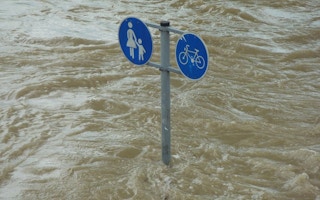Climate change affects us all, but we still are not acting as quickly as we should to address its causes, mitigate the damage, and adapt to its effects. Many people don’t understand the risks climate change poses to global economic and social structures. And, sadly, many who do understand are dismissive of the far-reaching benefits a global shift to sustainability and clean energy would bring about.
To continue reading, subscribe to Eco‑Business.
There's something for everyone. We offer a range of subscription plans.
- Access our stories and receive our Insights Weekly newsletter with the free EB Member plan.
- Unlock unlimited access to our content and archive with EB Circle.
- Publish your content with EB Premium.
According to a recent Pew study, seven out of ten Americans classified as political independents were not very concerned that climate change would hurt them. Worse still, Yale University researchers recently found that 40 per cent of adults worldwide have never even heard of climate change. In some developing countries, such as India, that figure climbs to 65 per cent.
These figures are discouraging, but they can be improved. The Yale study concluded that, “educational attainment tends to be the single strongest predictor of public awareness of climate change.” By investing in quality education, we can set the next generation on the right path to addressing this global problem.
Education and climate action work together in three ways. For starters, education fills knowledge gaps. Understanding how climate change is already having an impact on one’s life can have practical benefits. This is especially true for poor populations that are most vulnerable to crop failures and natural disasters, such as landslides and floods, caused by climate change.
Populations that must rebuild from scratch after each new catastrophe miss out on opportunities for rapid development. By understanding that their world is changing – and that the likelihood of future disasters is increasing – these populations can build resilience and learn to adapt to the sudden and slow stresses of a changing climate.
Second, education challenges apathy. Knowing the measures available to address climate change can open up vast opportunities for economic growth. Global investors should be made to understand that sustainable solutions can increase wellbeing and create additional economic opportunities.
To take one example, in Niger, education and improved farming techniques helped double real farm incomes for more than one million people, while restoring huge tracts of severely degraded land. In the US, as of 2014, there were more jobs that depended on solar energy than on coal mining.
“
Solutions may come from tech hubs, but they will also come from villages and developing cities, from farmers and manufactures with vastly different perspectives on the world around them.
Still, many people insist that implementing measures to mitigate the effects of climate change is too costly to our current way of life. According to the Pew study, almost seven out of ten people believe that, given the limitations of technology, they would have to make major lifestyle changes.
This does not have to be the case, and education can challenge the kind of skepticism that forecloses opportunities for climate-smart living.
Finally, education furnishes the technical knowledge needed to build a better future through innovation – one that includes clean and safe energy, sustainable agriculture, and smarter cities. Broadening access to education would lead to more homegrown innovation – entrepreneurs spotting opportunities to address local problems.
Globally, we cannot rely on knowledge centers such as Silicon Valley or Oxford to develop a silver bullet to the climate problem. Solutions may come from tech hubs, but they will also come from villages and developing cities, from farmers and manufactures with vastly different perspectives on the world around them. And this will create a virtuous cycle.
It is easier for educated people to migrate and integrate into new societies, sharing the knowledge they’ve brought with them.
Fortunately, younger generations today are better educated and more committed to reducing their own carbon footprint than previous generations were. They are leading the way and forcing us all to reconsider our own actions. But we must broaden the availability of education worldwide to ensure that their efforts are not in vain.
In recognition of education’s importance, the government of Norway, under the visionary leadership of Prime Minister Erna Solberg, has established the International Commission on Financing Global Education Opportunity, of which I am a member. We will meet this week in Oslo, and it is my hope that we will confront the challenges of our time and act on the knowledge that education is the best problem-solving asset we possess.
Addressing the dangers of climate change is not only an existential imperative; it is also an opportunity to move toward a cleaner, more productive, and fairer path of development. Only an educated global society can take the decisive action needed to get us there.
Felipe Calderón, former President of Mexico, is Chair of the Global Commission on the Economy and Climate.
Copyright: Project Syndicate, 2016.
www.project-syndicate.org











